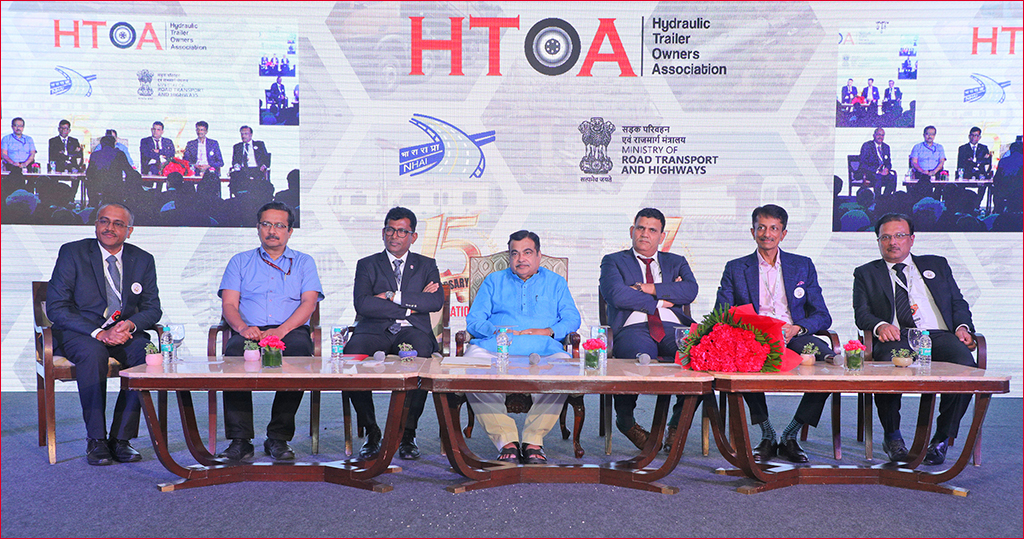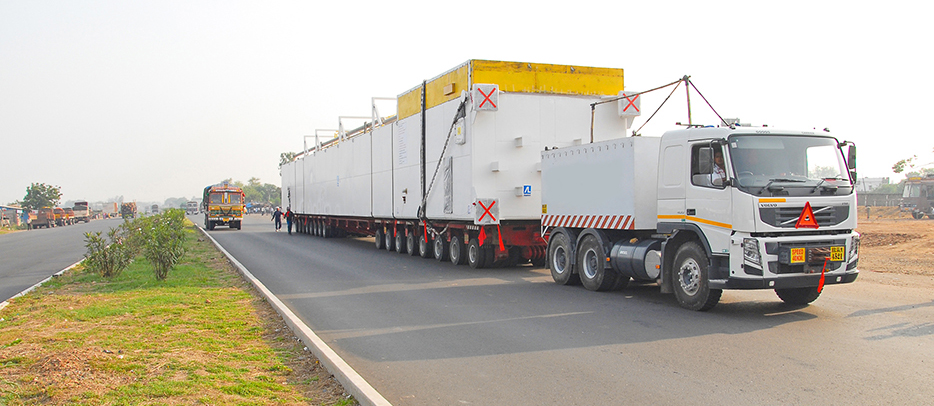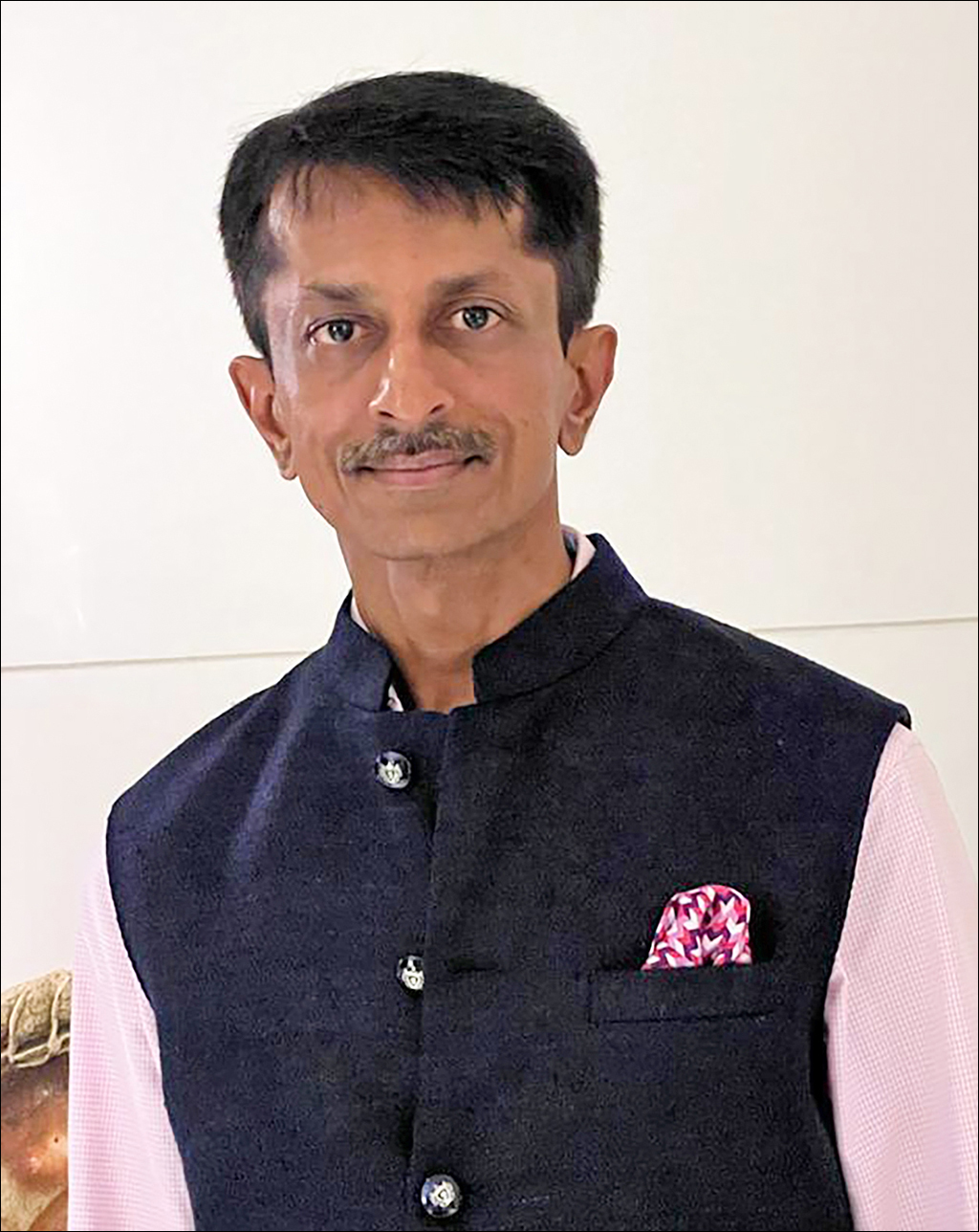
By raising critical matters with the government, particularly the Ministry of Road Transport & Highways, (MoRTH) the Hydraulic Trailer Owners Association (HTOA) has brought about significant reforms in the Heavy Lift & ODC Logistics Industry in India. Rajesh Rajgor interacted with prominent members of the association – Manish Kataria, Board Member, Jignesh Patel, Chairman, and Nilesh Sinha, Secretary, HTOA to gain insights about this segment of the transportation industry.
Hydraulic Trailer Owners Association (HTOA) have brought comprehensive changes in the Heavy Lift & ODC Logistics Industry by taking up pressing issues with the Government specially the Ministry of Road Transport & Highways (MoRTH). The active support of the Central Government gave recognition of the Hydraulic Trailers in the CMV Rules, 1989 which was pending for over 3 decades. The recognition also introduces a number of rules and procedures for the efficient transit of project goods, which aids in the nation’s infrastructure development.

The HTOA AGM was attended by 65 registered members and more than 100 other people. Top representatives from TII Sales, Germany were present, in addition to Manish Kataria, Chairman, Bharat Gandhi, Vice Chairman, Jignesh Patel, Secretary, T.G. Ramalingam, Jt. Secretary, Sukhvinder Singh, Treasurer and Rajesh Gupta, Ex-Chairman.
Nitin Gadkari, Union Road Transport and Highways Minister, launched the online approval process for permissions, which has resulted in more than 2500 online permissions since January 2015. HTOA evaluated each and every one of the accomplishments, including this one. Other concerns with hydraulic trailers include renewal of fitness, difficulties operators in different states confront, states that don’t adhere to Central Government programmes and have their own procedures, etc.
The timely delivery of vital project components in the infrastructure sector, including power, steel, cement, oil & gas, and railways, has directly contributed to the economy’s expansion. As active participants in their events, global and Indian manufacturers of hydraulic trailers, heavy prime movers, tyres, oil & lubricants, and other machineries across industries support HTOA’s endeavours.
Additionally, HTOA expressed their gratitude to EXIM MALA Awards for honoring HTOA at the most recent MALA Awards ceremony in Mumbai in order to recognize their efforts.

Could you share a brief history about HTOA and how is the Hydraulic Trailers Owners Association different from a normal trailer association?
Manish Kataria: HTOA is one of the more structured and organized association which help its member to acquire and disseminate knowledge about the working of Hydraulic Trailer operations in different countries and induce the members to raise their service standard to various core industries by issuing circulars, pamphlets and periodicals and literature on best practices being followed globally.
As one of the early breakthroughs of HTOA wherein its effort helped its member by issuance of guidelines by MORTH on independent GVW for the modular Hydraulic trailer combinations with no consideration for registered laden weight of Puller Tractor as basis for computing GVW for the purpose of computation of excess weight u/s 194 of MV Act,1988. This supported to consider the heavy movement in India as part of mainstream transportation mode with clarity on its rules and regulation at par with other trailers movement. This success differentiates HTOA with others association as HTOA advocacy helped to attract regulator attention and frame/structure rules for the heavy movement in India.
What is the current strength of members associated with you and the vision that is driving HTOA?
Manish Kataria: HTOA is continuously promoting the secure and efficient transportation of large, oversize equipment throughout India. About 160 businesses and firms own the approximately 30,000 axle rows and 1,500 heavy-duty puller tractors that make up the whole market for heavy equipment. HTOA now has 65 registered members, which serves roughly 85% of the market. We are working to close the communication gap between government agencies, members and road transport policies in India. We try to use road transportation to promote economic progress. In order to make India a world leader in road transportation, we are also concentrating on the skill development of the workers in the transportation sector. Our mission is to expedite the development of the nation through self-reliance and timely logistics of essential supplies.
What are the aspects on which the association members collaborate with each other and how do you see this going forward as a mission and objective perspective for HTOA?
Manish Kataria: Our members are primarily collaborating on the safe movement, information sharing related to engineering support and solutions to explore movement of over dimension and heavy equipment. We also collaborate on regional expertise and infrastructural support to ensure the availability of support system during movement of heavy equipment.
Going forward we are trying to develop skill related to crew, operating team and engineering team along with setting up 24×7 support system to our member. Very soon we are creating regional chapter of HTOA and this initiative already started getting support from members across the country.

How has the single window authorization benefited the trailer sector and ODC operators?
Jignesh Patel: Single window permission has acted as a boon to reduce the idle time of trailer, manpower and reduced the transit time thereby provide predictability to the end client to plan the work in advance to optimize project execution time and reduce overall project delays due to uncertainty which was prevailing in the past.
Has FASTag been put into use on state highways for you? How has it facilitated operators’ quick movement?
Jignesh Patel: HTOA had represented to MoRTH on the harassment of the hydraulic trailer operators at the toll plaza’s owing to the combination of independently registered Puller Tractor and modular hydraulic trailers despite the user fee rules having specific category of ODC or vehicles with 7 axles or more and as a solution HTOA requested the Ministry for a cash less system through FASTag facility to overcome this corrupt practice.
Ministry considering the same announced FASTag cashless facility to all Puller Tractor & modular hydraulic trailer combinations in line with Government’s policy of CASHLESS TOLLING & Ease of Doing Business. On State Highways, however, the FASTag and online permission is still not implemented considering the Federal structure, wherein each State has to be persuaded for implementation individually.

Could you share information on HTOA activities so that the members can obtain the best equipment from international and Indian producers of hydraulic trailers, heavy prime movers, tyres, oil and lubricants, etc.?
Jignesh Patel: HTOA under close co-ordination with MoRTH, engaged leading Bridge engineers as consultants committee which carried out detailed study & submitted its detailed report which paved the path for framing & publication of policy guidelines by MoRTH for grant of movement permission of ODC/OWC over modular hydraulic trailer on National Highways. This led to promotion of compliance and safety of road and bridge infrastructure by curbing overloading.
With HTOA consistent effort, in order to curb overloading and promote use of state-of-the-art trailer which can evenly transfer concentrated load across multiple axle rows by using its hydraulic function, Module Hydraulic Trailer were inserted in the Central Motor Vehicle Rules, 1989. The loading arrangements frequently used in ODC/OWC movement over hydraulic trailers were categorized as HT1 to HT13 and wide guidelines were published by the Ministry in this regard. This led to opening up of world class trailer / axle market in India wherein safety of road, bridges took the center stage while moving heavy and over dimension cargo. Leading globally established hydraulic trailer manufacturers started setting up facilities in India and also localized the equipment to meet local requirement.
The globally established puller tractor leading manufacturer also introduced various new model keeping safety and maneuverability of trailer over all kind of road, bridges and hilly terrain.

As an association what are your demands from the government be it in insurance, load management and taxes?
Nilesh Sinha: We have appraised the Ministry on disparities related to liability on carrier under the prevailing Carriage by Road Rules, 2011. Unlike the other modes of transportation viz. Water, Rail & Air, where the carrier liability is co-related to weight of the consignment being carried along with reasonable cap on maximum liability. In India the carrier liability is 10 times of the contract value. This clause is adversely affecting operator and its being misused by the heavy equipment manufacturer.
How is the association tackling these and other problems right now?
Nilesh Sinha: The heavy movement is highly skill business and therefore skill driver, operator, crew and engineers are required but our academic institutions have still not designed any specific learning tools to attract the new talent in this field which has vast opportunities.
At HTOA, we are in touch with several institution and overseas experts to design modules to train manpower at each layer. HTOA publishes India’s first heavy lift journals ‘Heavyhaulers’ to share latest operating and technical information to the members and stakeholders along with various regulatory updates. HTOA is pursuing with Ministry for amendment to carriage by Road Rules, 2011 w.r.t. liability on common carrier in case of loss/damage to consignment during transit.